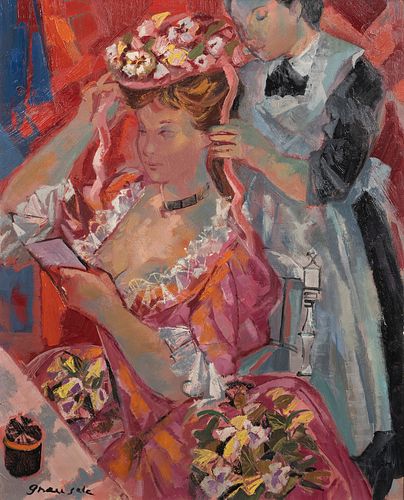EMILIO GRAU SALA (Barcelona, 1911 - Paris, 1975). "Comedienne dans l`Eloge", Paris, 1957. Oil on canvas. Signed in the lower right corner. Signed,
Lot 59
About Seller
Setdart Auction House
Carrer Aragó 346
Barcelona
Spain
Setdart Subastas was born in 2004 and is currently the first online art auction in Spain with solidity, prestige and reliability guaranteed by our more than 60,000 users. Setdart has a young, dynamic and enterprising team ready to successfully manage the purchase and sale of art works through custom...Read more
Estimate:
EUR€10,000 - EUR€12,000
$10,752.69 - $12,903.23
Absentee vs Live bid
Two ways to bid:
- Leave a max absentee bid and the platform will bid on your behalf up to your maximum bid during the live auction.
- Bid live during the auction and your bids will be submitted real-time to the auctioneer.
Bid Increments
| Price | Bid Increment |
|---|---|
| EUR€0 | EUR€10 |
| EUR€200 | EUR€25 |
| EUR€500 | EUR€50 |
| EUR€1,000 | EUR€100 |
| EUR€3,000 | EUR€200 |
| EUR€5,000 | EUR€500 |
| EUR€10,000 | EUR€1,000 |
| EUR€20,000 | EUR€2,000 |
| EUR€50,000 | EUR€5,000 |
About Auction
By Setdart Auction House
Oct 27, 2021
Set Reminder
2021-10-27 10:00:00
2021-10-27 10:00:00
America/New_York
Bidsquare
Bidsquare : 19th & 20th Century Paintings & Decorative Arts
https://www.bidsquare.com/auctions/setdart-auction-house/19th-20th-century-paintings-decorative-arts-7767
Setdart Auction House sofia@setdart.com
Setdart Auction House sofia@setdart.com
- Lot Description
EMILIO GRAU SALA (Barcelona, 1911 - Paris, 1975). "Comedienne dans l`Eloge", Paris, 1957. Oil on canvas. Signed in the lower right corner. Signed, dated, located and titled on the back. Size: 56 x 67 cm; 69 x 80 cm (frame). While it reviews for the last time the script before going out to scene, an actress of theater is being combed by a servant, who at this moment is tying the ribbons of a showy hat to her. The interior of the dressing room is barely hinted at by a few notes of color, for it is the beautiful lady and her maid who occupy a large part of the picture. As usual in Grau Sala's paintings, the costumes are described as a pure chromatic symphony on the smooth silk, among lace, drapes and pleats. The flowers seem to come out of the print and take on a life of their own. The author contrasts the warmth and chromatic vivacity of the young woman with the black and white sobriety of the servant, who wears a white cotton apron over a black dress. The faces also reveal the role assigned to whom: silent and humble, the maid; haughty, the mistress. This is an important work by Grau Sala, resolved with exquisite drawing, rich and sensual qualities. Son of the draftsman Juan Grau Miró, Grau Sala combined his attendance at the School of Fine Arts in Barcelona with an essentially self-taught training. In 1930 he held his first exhibition at the Badriñas gallery in Barcelona. At the beginning of the Civil War, in 1936, he moved to Paris, where he settled in the Spanish artists' colony of Montparnasse. That same year he was awarded the first Carnegie Prize. In the twenty-five years he stayed there, he was closely acquainted with the avant-garde, although he always opted for a colorist figuration, derived from impressionism and fauvism. It was a path already taken by the commercial circuit, surpassed in terms of novelty by cubism and surrealism, but which was kept alive at a high level thanks to masters such as Bonnard, Chagall and Dufy. In fact, he soon became known in Paris as the successor of the Impressionist spirit and values, directly related to Bonnard and Vuillard. This stylistic choice of Grau Sala conditioned that of his wife, Ángeles Santos, who abandoned her singular surrealism for a more conventional landscape, a decision that critics did not hesitate to regret. The success of his style led Grau Sala to devote himself also to graphic work (engravings, lithographs, illustrations for novels, posters...), as well as theatrical sets. Works by Emilio Grau Sala are preserved in the National Art Museum of Catalonia, the Esteban Vicente Museum of Contemporary Art and the Óscar Domínguez Institute of Contemporary Art and Culture.
- Shipping Info
-
In-house shipping available. Please inquire at admin@setdart.com.
-
- Buyer's Premium



 EUR
EUR CAD
CAD AUD
AUD GBP
GBP MXN
MXN HKD
HKD CNY
CNY MYR
MYR SEK
SEK SGD
SGD CHF
CHF THB
THB















